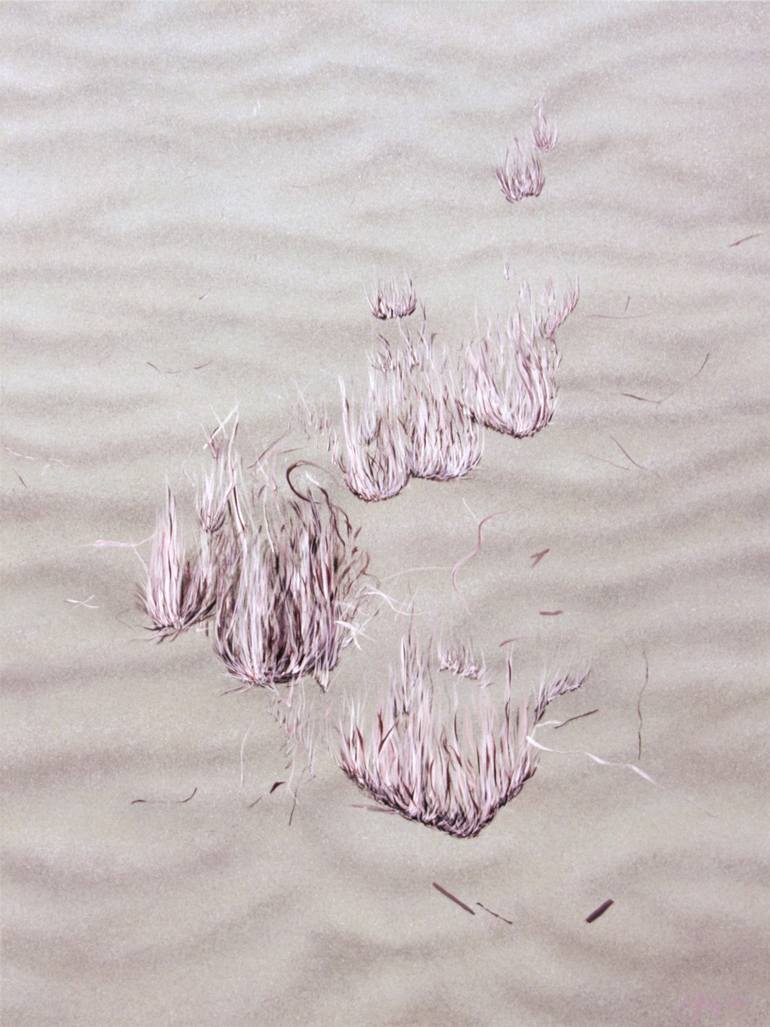





VIEW IN MY ROOM
Unnoticed pale pink seagrass tuft, Impression of a beach walk (5) Print
Austria
Select a Material
Fine Art Paper
Select a Size
9 x 12 in ($40)
Add a Frame
White ($80)
Artist Recognition

Artist featured in a collection
About The Artwork
Like almost all pictures of this series, this one was taken during one of my walks on the beach of Grado at low tide. As soon as the water retreats, this reveals the mudflats of hidden beauties, over which most beach runners carelessly walk, even often find disgusting. But on closer inspection, one can discover, perceive and enjoy these gems thrown at our feet by Mother Nature, which can sometimes not be more transient. Now sand contains the basic structure that I meet with my painting technique, especially when I work with acrylic on canvas. I call this technique hammer-hitting technique, as I hit a hammer handle with an almost dry brush to bring the paint to the canvas. In the end, it looks a bit like pointillism, but it is not, because, unlike pointillism, the color dots are not specifically applied to the canvas. It is more like a rough airbrush. So many layers are laid out until a coherent whole comes to a coherent whole. I drew the seaweed with the brush. Controlled brush strokes allow me to create tension using two different painting techniques. Uncontrolled and controlled paint application. In this picture I was fascinated by the structure in the sand shaped by the wave movement as well as the seagrass tufts, which just lie flat and wait until the next flood washthems around them. Also, the color of the seaweed, a pale white-pink and dark stalk, had caught my eye. What poetry is found here again is fantastic, the rhythm of the waves-shaped sand with the seagrass bushes. Something so commonplace and yet unique. But it is also significant for us human beings that we are often no longer able to perceive these beautiful little things as such. And so, in this series I also set myself the task of bringing these mostly unnoticed coincidences into the center of the viewer. Not by a simple photograph, but to lift and appreciate it into a new dimension by means of my painting technique.
Details & Dimensions
Print:Giclee on Fine Art Paper
Size:9 W x 12 H x 0.1 D in
Size with Frame:14.25 W x 17.25 H x 1.2 D in
Frame:White
Ready to Hang:Yes
Packaging:Ships in a Box
Shipping & Returns
Delivery Time:Typically 5-7 business days for domestic shipments, 10-14 business days for international shipments.
Handling:Ships in a box. Art prints are packaged and shipped by our printing partner.
Ships From:Printing facility in California.
Have additional questions?
Please visit our help section or contact us.
Austria
In Erik Oliver Anders' work, there is something that connects his different subjects, something that is more than just a formal singularity or a stylistic characteristic: it is the “drop of paint”. His painting techniques are inspired by the early atomic teachings of Ancient Greece (for example those of philosopher Democritus, who lived around 450 BC) or by the Indian "Milinda Panha", a dialogue between the Buddhist sage Nāgasena and the Indo-Greek king Menander I about the whole and its parts (200-100 BC), as well as by modern particle physics. Nothing in essence is as it appears. Most of what we consider as solid matter is void. For his pictures, Erik Anders uses a basic building block: the drop of paint. Here we find echoes of the pointillism of Georges Seurat from the 1880s - or clear parallels to the action painting of Jackson Pollock in the first half of the 20th century. Erik Anders also refers to a series of his works as "drippings". Erik Anders’ intention is to control the drop, to use it purposefully. Over the past 15 years, he has become a "tamer” of paint drops. First, he lets the drop flow on the canvas (Anders also mentions Nitsch as a model). Lines are created. Rotating the canvas also changes the direction of the flow and, consequently, the course of the lines. By doing so, he creates his basic elements: points and lines. Grids are created, superimposed in several layers, forming abstract structures, yet still evoking the impression of buildings, cities and sceneries. This interplay of literalism and abstraction also recalls Kandinsky's theoretical work "On the Spiritual in Art" (1910) or Japanese Buddhism, freely formulated as "Zen, or the art of letting drops fall". Erik Oliver Anders has a very precise idea and sketches of each of his paintings. Then, he sets out to translate this idea as accurately as possible on a big canvas. Random forms are excluded as far as possible. In several layers, partly reminiscent of Mark Rothko’s glazes, spatial effects are created, which play with concealing and transparency. With this elaborate painting technique, through different grid structures, drop shapes and sizes, he achieves an almost three-dimensional depth effect and permeability. This permeability and openness is also characteristic of Erik Anders' lifestyle. Always curious, open for new things, quick to take up new topics - especially "funny" ones. He loves to play with elements, but also to take an in-depth view at things.
Artist Recognition

Artist featured by Saatchi Art in a collection
Thousands Of Five-Star Reviews
We deliver world-class customer service to all of our art buyers.
Global Selection
Explore an unparalleled artwork selection by artists from around the world.
Satisfaction Guaranteed
Our 14-day satisfaction guarantee allows you to buy with confidence.
Support An Artist With Every Purchase
We pay our artists more on every sale than other galleries.
Need More Help?